Analysis of Price Elasticity, Demand, and Revenue for a Business
VerifiedAdded on 2022/10/15
|7
|1731
|9
Homework Assignment
AI Summary
This assignment solution delves into the core concepts of price elasticity of demand, offering a comprehensive analysis of its various aspects. The solution begins by illustrating the price elasticity of demand at different points on a demand curve and explaining the underlying economic principles. It then presents a detailed examination of a demand equation, interpreting the coefficients related to price, cross-price, and income elasticities. The solution calculates the price elasticity, cross-price elasticity, and income elasticity based on provided values, followed by an explanation of these elasticities. The assignment also explores the impact of price changes on revenue and discusses the significance of the algebraic sign of elasticity in economic analysis. Furthermore, it examines real-world applications, such as the inelastic demand for fuel and the impact of diminishing marginal utility on consumer spending. The solution concludes with a budget constraint problem, determining optimal consumption choices and maximizing utility. The document incorporates relevant references to support the analysis.
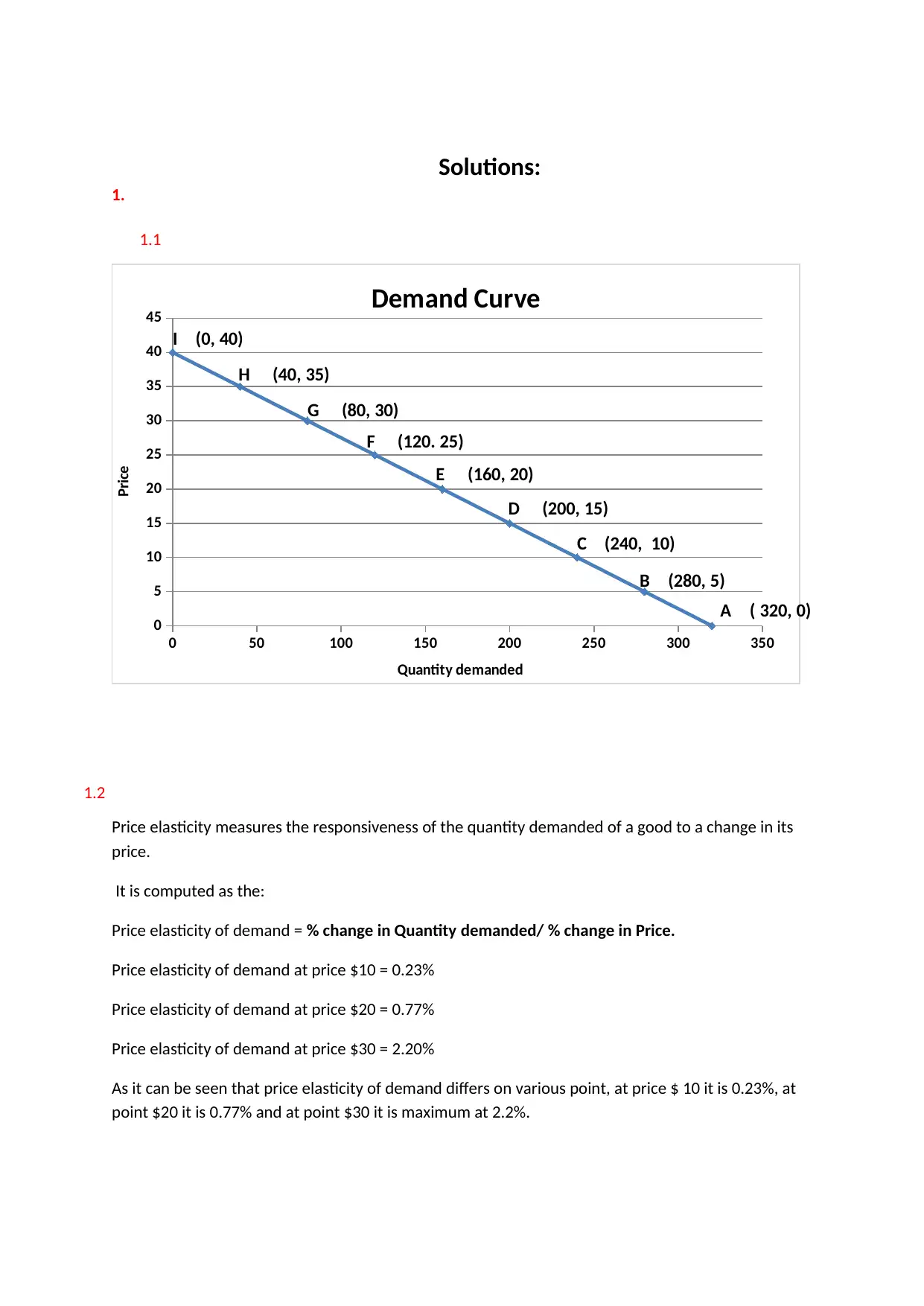
Solutions:
1.
1.1
0 50 100 150 200 250 300 350
0
5
10
15
20
25
30
35
40
45
A ( 320, 0)
B (280, 5)
C (240, 10)
D (200, 15)
E (160, 20)
F (120. 25)
G (80, 30)
H (40, 35)
I (0, 40)
Demand Curve
Quantity demanded
Price
1.2
Price elasticity measures the responsiveness of the quantity demanded of a good to a change in its
price.
It is computed as the:
Price elasticity of demand = % change in Quantity demanded/ % change in Price.
Price elasticity of demand at price $10 = 0.23%
Price elasticity of demand at price $20 = 0.77%
Price elasticity of demand at price $30 = 2.20%
As it can be seen that price elasticity of demand differs on various point, at price $ 10 it is 0.23%, at
point $20 it is 0.77% and at point $30 it is maximum at 2.2%.
1.
1.1
0 50 100 150 200 250 300 350
0
5
10
15
20
25
30
35
40
45
A ( 320, 0)
B (280, 5)
C (240, 10)
D (200, 15)
E (160, 20)
F (120. 25)
G (80, 30)
H (40, 35)
I (0, 40)
Demand Curve
Quantity demanded
Price
1.2
Price elasticity measures the responsiveness of the quantity demanded of a good to a change in its
price.
It is computed as the:
Price elasticity of demand = % change in Quantity demanded/ % change in Price.
Price elasticity of demand at price $10 = 0.23%
Price elasticity of demand at price $20 = 0.77%
Price elasticity of demand at price $30 = 2.20%
As it can be seen that price elasticity of demand differs on various point, at price $ 10 it is 0.23%, at
point $20 it is 0.77% and at point $30 it is maximum at 2.2%.
Paraphrase This Document
Need a fresh take? Get an instant paraphrase of this document with our AI Paraphraser
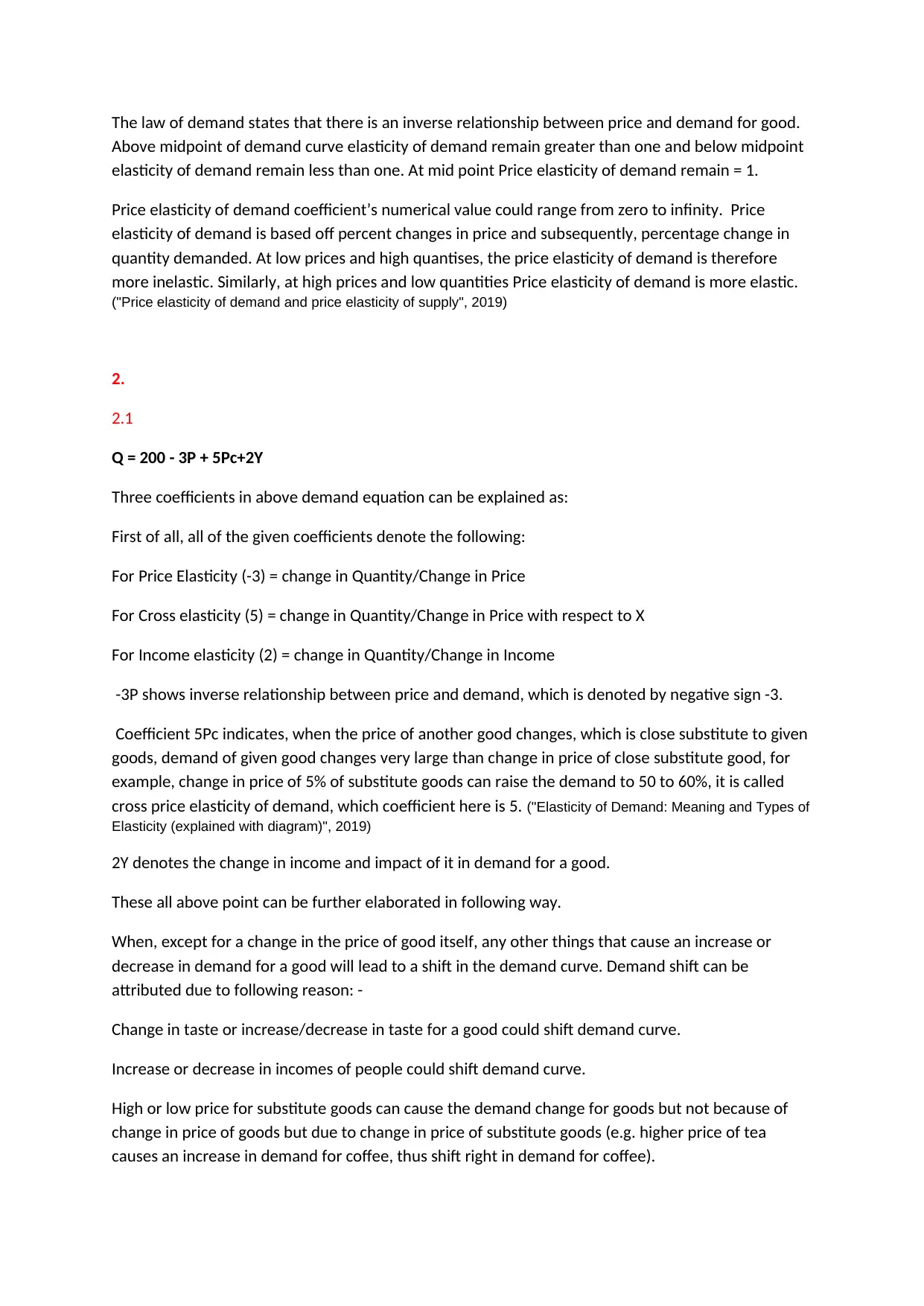
The law of demand states that there is an inverse relationship between price and demand for good.
Above midpoint of demand curve elasticity of demand remain greater than one and below midpoint
elasticity of demand remain less than one. At mid point Price elasticity of demand remain = 1.
Price elasticity of demand coefficient’s numerical value could range from zero to infinity. Price
elasticity of demand is based off percent changes in price and subsequently, percentage change in
quantity demanded. At low prices and high quantises, the price elasticity of demand is therefore
more inelastic. Similarly, at high prices and low quantities Price elasticity of demand is more elastic.
("Price elasticity of demand and price elasticity of supply", 2019)
2.
2.1
Q = 200 - 3P + 5Pc+2Y
Three coefficients in above demand equation can be explained as:
First of all, all of the given coefficients denote the following:
For Price Elasticity (-3) = change in Quantity/Change in Price
For Cross elasticity (5) = change in Quantity/Change in Price with respect to X
For Income elasticity (2) = change in Quantity/Change in Income
-3P shows inverse relationship between price and demand, which is denoted by negative sign -3.
Coefficient 5Pc indicates, when the price of another good changes, which is close substitute to given
goods, demand of given good changes very large than change in price of close substitute good, for
example, change in price of 5% of substitute goods can raise the demand to 50 to 60%, it is called
cross price elasticity of demand, which coefficient here is 5. ("Elasticity of Demand: Meaning and Types of
Elasticity (explained with diagram)", 2019)
2Y denotes the change in income and impact of it in demand for a good.
These all above point can be further elaborated in following way.
When, except for a change in the price of good itself, any other things that cause an increase or
decrease in demand for a good will lead to a shift in the demand curve. Demand shift can be
attributed due to following reason: -
Change in taste or increase/decrease in taste for a good could shift demand curve.
Increase or decrease in incomes of people could shift demand curve.
High or low price for substitute goods can cause the demand change for goods but not because of
change in price of goods but due to change in price of substitute goods (e.g. higher price of tea
causes an increase in demand for coffee, thus shift right in demand for coffee).
Above midpoint of demand curve elasticity of demand remain greater than one and below midpoint
elasticity of demand remain less than one. At mid point Price elasticity of demand remain = 1.
Price elasticity of demand coefficient’s numerical value could range from zero to infinity. Price
elasticity of demand is based off percent changes in price and subsequently, percentage change in
quantity demanded. At low prices and high quantises, the price elasticity of demand is therefore
more inelastic. Similarly, at high prices and low quantities Price elasticity of demand is more elastic.
("Price elasticity of demand and price elasticity of supply", 2019)
2.
2.1
Q = 200 - 3P + 5Pc+2Y
Three coefficients in above demand equation can be explained as:
First of all, all of the given coefficients denote the following:
For Price Elasticity (-3) = change in Quantity/Change in Price
For Cross elasticity (5) = change in Quantity/Change in Price with respect to X
For Income elasticity (2) = change in Quantity/Change in Income
-3P shows inverse relationship between price and demand, which is denoted by negative sign -3.
Coefficient 5Pc indicates, when the price of another good changes, which is close substitute to given
goods, demand of given good changes very large than change in price of close substitute good, for
example, change in price of 5% of substitute goods can raise the demand to 50 to 60%, it is called
cross price elasticity of demand, which coefficient here is 5. ("Elasticity of Demand: Meaning and Types of
Elasticity (explained with diagram)", 2019)
2Y denotes the change in income and impact of it in demand for a good.
These all above point can be further elaborated in following way.
When, except for a change in the price of good itself, any other things that cause an increase or
decrease in demand for a good will lead to a shift in the demand curve. Demand shift can be
attributed due to following reason: -
Change in taste or increase/decrease in taste for a good could shift demand curve.
Increase or decrease in incomes of people could shift demand curve.
High or low price for substitute goods can cause the demand change for goods but not because of
change in price of goods but due to change in price of substitute goods (e.g. higher price of tea
causes an increase in demand for coffee, thus shift right in demand for coffee).
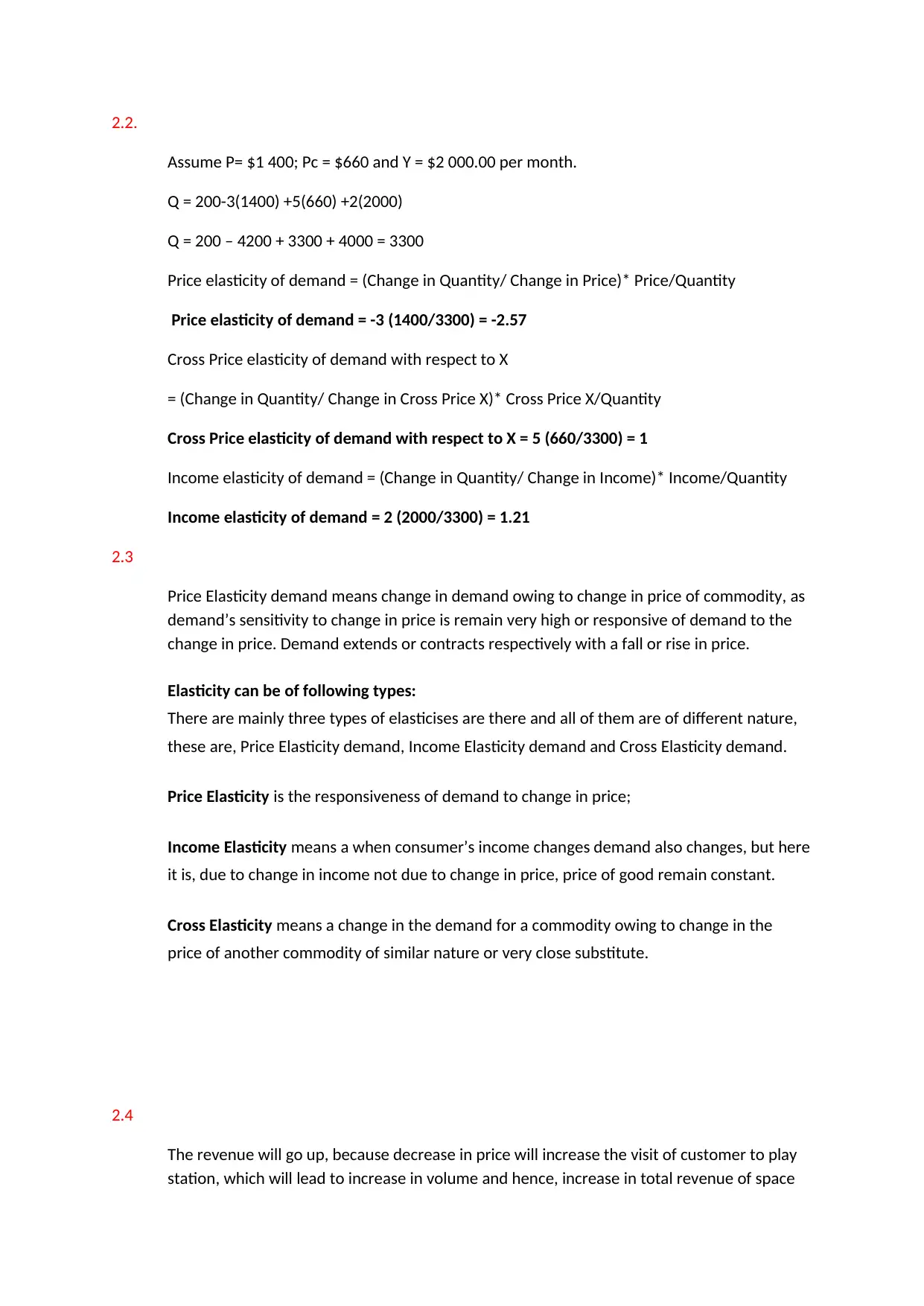
2.2.
Assume P= $1 400; Pc = $660 and Y = $2 000.00 per month.
Q = 200-3(1400) +5(660) +2(2000)
Q = 200 – 4200 + 3300 + 4000 = 3300
Price elasticity of demand = (Change in Quantity/ Change in Price)* Price/Quantity
Price elasticity of demand = -3 (1400/3300) = -2.57
Cross Price elasticity of demand with respect to X
= (Change in Quantity/ Change in Cross Price X)* Cross Price X/Quantity
Cross Price elasticity of demand with respect to X = 5 (660/3300) = 1
Income elasticity of demand = (Change in Quantity/ Change in Income)* Income/Quantity
Income elasticity of demand = 2 (2000/3300) = 1.21
2.3
Price Elasticity demand means change in demand owing to change in price of commodity, as
demand’s sensitivity to change in price is remain very high or responsive of demand to the
change in price. Demand extends or contracts respectively with a fall or rise in price.
Elasticity can be of following types:
There are mainly three types of elasticises are there and all of them are of different nature,
these are, Price Elasticity demand, Income Elasticity demand and Cross Elasticity demand.
Price Elasticity is the responsiveness of demand to change in price;
Income Elasticity means a when consumer’s income changes demand also changes, but here
it is, due to change in income not due to change in price, price of good remain constant.
Cross Elasticity means a change in the demand for a commodity owing to change in the
price of another commodity of similar nature or very close substitute.
2.4
The revenue will go up, because decrease in price will increase the visit of customer to play
station, which will lead to increase in volume and hence, increase in total revenue of space
Assume P= $1 400; Pc = $660 and Y = $2 000.00 per month.
Q = 200-3(1400) +5(660) +2(2000)
Q = 200 – 4200 + 3300 + 4000 = 3300
Price elasticity of demand = (Change in Quantity/ Change in Price)* Price/Quantity
Price elasticity of demand = -3 (1400/3300) = -2.57
Cross Price elasticity of demand with respect to X
= (Change in Quantity/ Change in Cross Price X)* Cross Price X/Quantity
Cross Price elasticity of demand with respect to X = 5 (660/3300) = 1
Income elasticity of demand = (Change in Quantity/ Change in Income)* Income/Quantity
Income elasticity of demand = 2 (2000/3300) = 1.21
2.3
Price Elasticity demand means change in demand owing to change in price of commodity, as
demand’s sensitivity to change in price is remain very high or responsive of demand to the
change in price. Demand extends or contracts respectively with a fall or rise in price.
Elasticity can be of following types:
There are mainly three types of elasticises are there and all of them are of different nature,
these are, Price Elasticity demand, Income Elasticity demand and Cross Elasticity demand.
Price Elasticity is the responsiveness of demand to change in price;
Income Elasticity means a when consumer’s income changes demand also changes, but here
it is, due to change in income not due to change in price, price of good remain constant.
Cross Elasticity means a change in the demand for a commodity owing to change in the
price of another commodity of similar nature or very close substitute.
2.4
The revenue will go up, because decrease in price will increase the visit of customer to play
station, which will lead to increase in volume and hence, increase in total revenue of space
⊘ This is a preview!⊘
Do you want full access?
Subscribe today to unlock all pages.

Trusted by 1+ million students worldwide
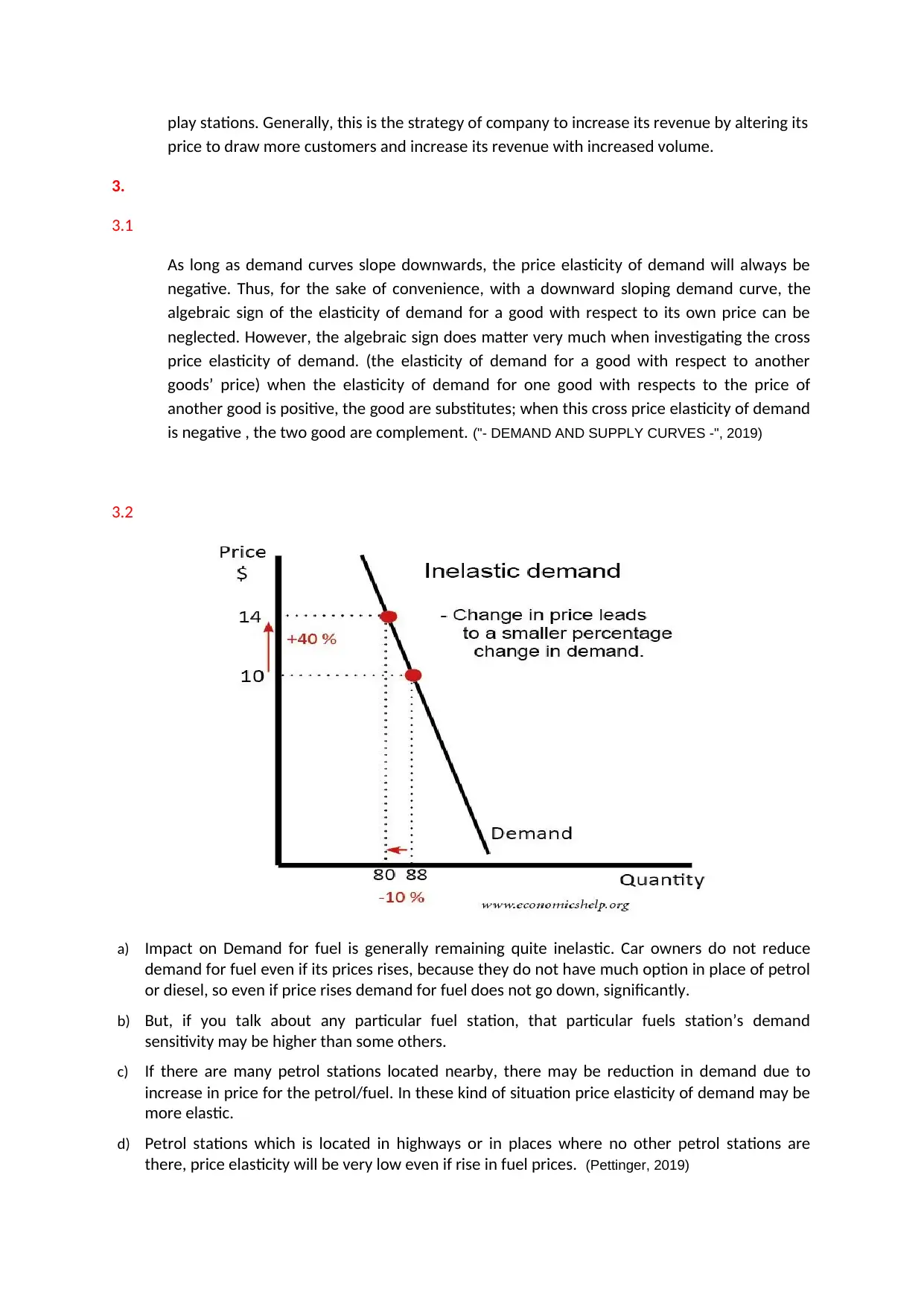
play stations. Generally, this is the strategy of company to increase its revenue by altering its
price to draw more customers and increase its revenue with increased volume.
3.
3.1
As long as demand curves slope downwards, the price elasticity of demand will always be
negative. Thus, for the sake of convenience, with a downward sloping demand curve, the
algebraic sign of the elasticity of demand for a good with respect to its own price can be
neglected. However, the algebraic sign does matter very much when investigating the cross
price elasticity of demand. (the elasticity of demand for a good with respect to another
goods’ price) when the elasticity of demand for one good with respects to the price of
another good is positive, the good are substitutes; when this cross price elasticity of demand
is negative , the two good are complement. ("- DEMAND AND SUPPLY CURVES -", 2019)
3.2
a) Impact on Demand for fuel is generally remaining quite inelastic. Car owners do not reduce
demand for fuel even if its prices rises, because they do not have much option in place of petrol
or diesel, so even if price rises demand for fuel does not go down, significantly.
b) But, if you talk about any particular fuel station, that particular fuels station’s demand
sensitivity may be higher than some others.
c) If there are many petrol stations located nearby, there may be reduction in demand due to
increase in price for the petrol/fuel. In these kind of situation price elasticity of demand may be
more elastic.
d) Petrol stations which is located in highways or in places where no other petrol stations are
there, price elasticity will be very low even if rise in fuel prices. (Pettinger, 2019)
price to draw more customers and increase its revenue with increased volume.
3.
3.1
As long as demand curves slope downwards, the price elasticity of demand will always be
negative. Thus, for the sake of convenience, with a downward sloping demand curve, the
algebraic sign of the elasticity of demand for a good with respect to its own price can be
neglected. However, the algebraic sign does matter very much when investigating the cross
price elasticity of demand. (the elasticity of demand for a good with respect to another
goods’ price) when the elasticity of demand for one good with respects to the price of
another good is positive, the good are substitutes; when this cross price elasticity of demand
is negative , the two good are complement. ("- DEMAND AND SUPPLY CURVES -", 2019)
3.2
a) Impact on Demand for fuel is generally remaining quite inelastic. Car owners do not reduce
demand for fuel even if its prices rises, because they do not have much option in place of petrol
or diesel, so even if price rises demand for fuel does not go down, significantly.
b) But, if you talk about any particular fuel station, that particular fuels station’s demand
sensitivity may be higher than some others.
c) If there are many petrol stations located nearby, there may be reduction in demand due to
increase in price for the petrol/fuel. In these kind of situation price elasticity of demand may be
more elastic.
d) Petrol stations which is located in highways or in places where no other petrol stations are
there, price elasticity will be very low even if rise in fuel prices. (Pettinger, 2019)
Paraphrase This Document
Need a fresh take? Get an instant paraphrase of this document with our AI Paraphraser

4.
4.1
The law of diminishing marginal utility encourages people to spread their spending across many
different types of goods because the marginal utility decrease as more of that good is consumed so
in order for the body to be continually satisfied, other goods that make us feel good or has marginal
utility should be purchased or sought after.
4.2.1
Given that there is a budget constraint of $ 24 and that the price of each slice of Pizza is $ 6
and movie rental is $ 3 per rental.
The Pizza and movie rental are only available in whole number amounts.
The various combinations of two goods that one can purchase each week with the
budget are given by the equation:
$ 6 * Pizza slice + $ 3 * movie rental = $ 24, hence the various combinations are of both
the goods:
Possible
combinations
Budget
constraints
(in $)
Price of
slice of
pizza( in $)
Price of
movie
rental (in $)
Slice of
Pizza
Movie
rental
1 24 6 3 0 8
2 24 6 3 1 6
3 24 6 3 2 4
4 24 6 3 3 2
5 24 6 3 4 0
4.2.2
Pizza
slices/week
Total
utils/week
Marginal
Utility/week
Marginal
Utility
per $ for
Pizza
slice
Movie
rentals/week
Utils/week Marginal
Utility/week
Marginal
Utility
per $ for
Movie
rental
4.1
The law of diminishing marginal utility encourages people to spread their spending across many
different types of goods because the marginal utility decrease as more of that good is consumed so
in order for the body to be continually satisfied, other goods that make us feel good or has marginal
utility should be purchased or sought after.
4.2.1
Given that there is a budget constraint of $ 24 and that the price of each slice of Pizza is $ 6
and movie rental is $ 3 per rental.
The Pizza and movie rental are only available in whole number amounts.
The various combinations of two goods that one can purchase each week with the
budget are given by the equation:
$ 6 * Pizza slice + $ 3 * movie rental = $ 24, hence the various combinations are of both
the goods:
Possible
combinations
Budget
constraints
(in $)
Price of
slice of
pizza( in $)
Price of
movie
rental (in $)
Slice of
Pizza
Movie
rental
1 24 6 3 0 8
2 24 6 3 1 6
3 24 6 3 2 4
4 24 6 3 3 2
5 24 6 3 4 0
4.2.2
Pizza
slices/week
Total
utils/week
Marginal
Utility/week
Marginal
Utility
per $ for
Pizza
slice
Movie
rentals/week
Utils/week Marginal
Utility/week
Marginal
Utility
per $ for
Movie
rental

0 0 0 0 0 0 0 0
1 20 20 3.33 1 40 40 13.33
2 36 16 2.67 2 46 6 2.00
3 48 12 2.00 3 50 4 1.33
4 58 10 1.67 4 54 4 1.33
5 66 8 1.33 5 56 2 0.67
6 72 6 1.00 6 57 1 0.33
7 76 4 0.67 7 57 0 0.00
8 78 2 0.33 8 57 0 0.00
Looking at above table if tom spend $ 18 on 3 Pizza and $ 6 in two movies rental he will get
maximum satisfaction.
So, answer, 3 Pizzas * $ 6 = $ 18
2 Movies * $ 3 = $ 6, Total Spending amount given = $ 24
References:
1 20 20 3.33 1 40 40 13.33
2 36 16 2.67 2 46 6 2.00
3 48 12 2.00 3 50 4 1.33
4 58 10 1.67 4 54 4 1.33
5 66 8 1.33 5 56 2 0.67
6 72 6 1.00 6 57 1 0.33
7 76 4 0.67 7 57 0 0.00
8 78 2 0.33 8 57 0 0.00
Looking at above table if tom spend $ 18 on 3 Pizza and $ 6 in two movies rental he will get
maximum satisfaction.
So, answer, 3 Pizzas * $ 6 = $ 18
2 Movies * $ 3 = $ 6, Total Spending amount given = $ 24
References:
⊘ This is a preview!⊘
Do you want full access?
Subscribe today to unlock all pages.

Trusted by 1+ million students worldwide
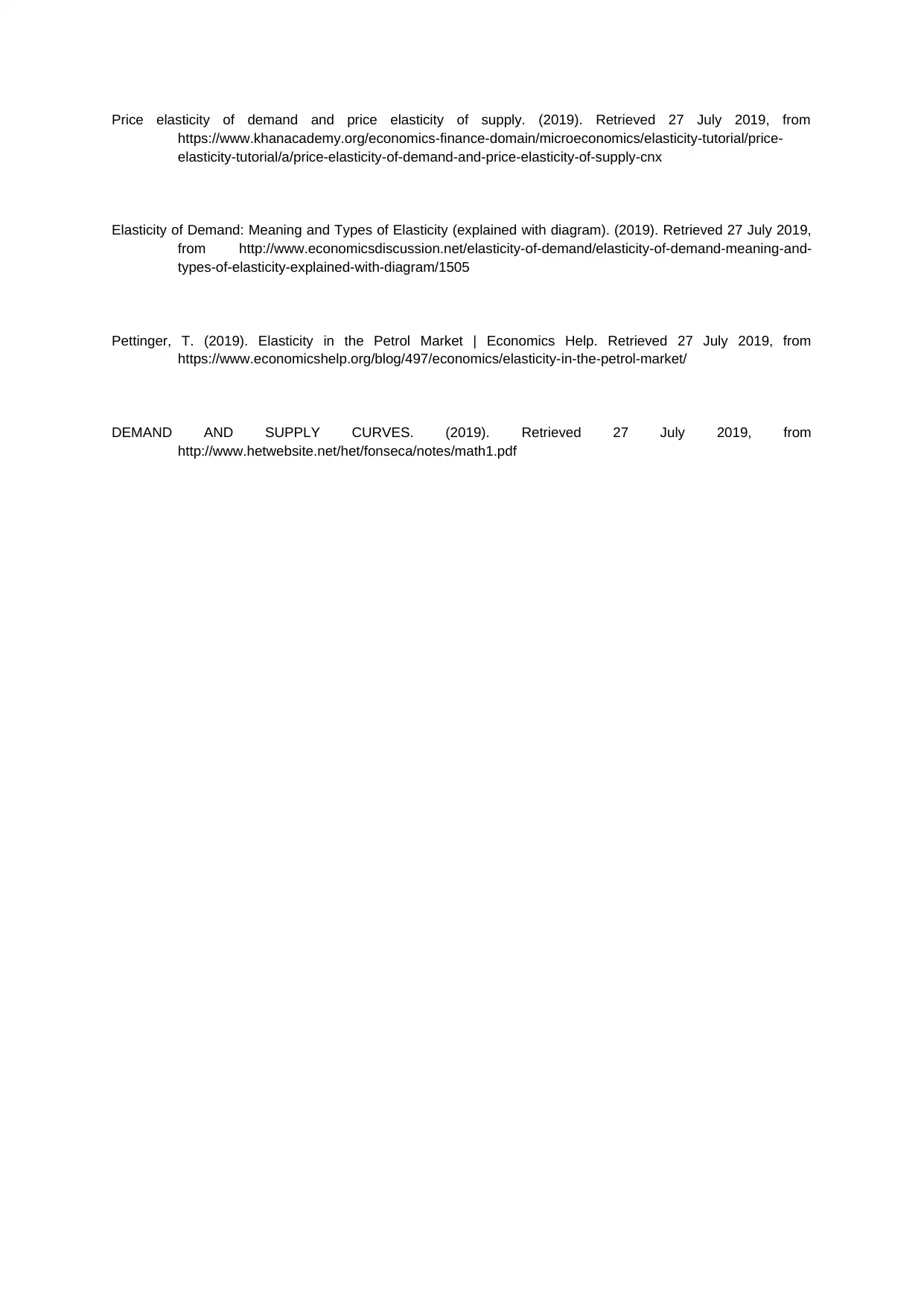
Price elasticity of demand and price elasticity of supply. (2019). Retrieved 27 July 2019, from
https://www.khanacademy.org/economics-finance-domain/microeconomics/elasticity-tutorial/price-
elasticity-tutorial/a/price-elasticity-of-demand-and-price-elasticity-of-supply-cnx
Elasticity of Demand: Meaning and Types of Elasticity (explained with diagram). (2019). Retrieved 27 July 2019,
from http://www.economicsdiscussion.net/elasticity-of-demand/elasticity-of-demand-meaning-and-
types-of-elasticity-explained-with-diagram/1505
Pettinger, T. (2019). Elasticity in the Petrol Market | Economics Help. Retrieved 27 July 2019, from
https://www.economicshelp.org/blog/497/economics/elasticity-in-the-petrol-market/
DEMAND AND SUPPLY CURVES. (2019). Retrieved 27 July 2019, from
http://www.hetwebsite.net/het/fonseca/notes/math1.pdf
https://www.khanacademy.org/economics-finance-domain/microeconomics/elasticity-tutorial/price-
elasticity-tutorial/a/price-elasticity-of-demand-and-price-elasticity-of-supply-cnx
Elasticity of Demand: Meaning and Types of Elasticity (explained with diagram). (2019). Retrieved 27 July 2019,
from http://www.economicsdiscussion.net/elasticity-of-demand/elasticity-of-demand-meaning-and-
types-of-elasticity-explained-with-diagram/1505
Pettinger, T. (2019). Elasticity in the Petrol Market | Economics Help. Retrieved 27 July 2019, from
https://www.economicshelp.org/blog/497/economics/elasticity-in-the-petrol-market/
DEMAND AND SUPPLY CURVES. (2019). Retrieved 27 July 2019, from
http://www.hetwebsite.net/het/fonseca/notes/math1.pdf
1 out of 7
Related Documents
Your All-in-One AI-Powered Toolkit for Academic Success.
+13062052269
info@desklib.com
Available 24*7 on WhatsApp / Email
![[object Object]](/_next/static/media/star-bottom.7253800d.svg)
Unlock your academic potential
Copyright © 2020–2025 A2Z Services. All Rights Reserved. Developed and managed by ZUCOL.





